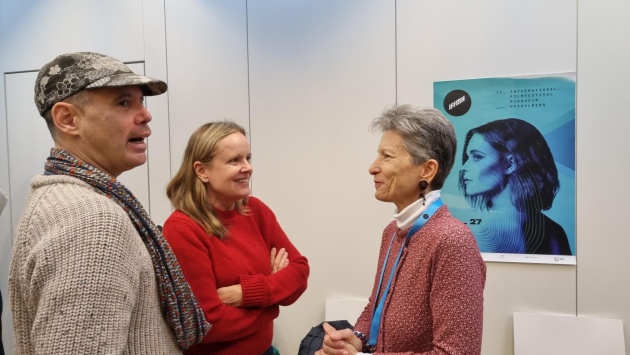The Fascination of Rituals

Magali von Reeth (right), Chairwoman of the SIGNIS Cinema Desk, talking with director Antoinette Boulat (middle), winner of the Ecumenical Prize at the Festival Mannheim-Heidelberg 2021
We often talk about Christians' attachment to cinema, as a path of faith, a crisp look to the world and a window open to an invisible kingdom. Today, I would like to reverse the discourse and evoke the fascination of filmmakers for the religious rituals.
I recently watched Tarik Saleh's Boy from Heaven (2022). It was obvious that the director was seduced by the theatrical staging of this environment. The students of the Koranic university - all dressed in large black robes and astonishing red and white hats - move as if they were gliding on a divine ether, in a courtyard open to the sky and closed by high walls to the outside world.
Just think of all those other films where, through a social, political or romantic intrigue, filmmakers from very different backgrounds felt for the beauty of religious rituals.
In Asia, Buddhism and Hinduism offer the astonishing orange color to the shades of the camera.
Where else can you see this color, in such fluidity? In 7 Years in Tibet by Jean-Jacques Annaud (1997) or in Little Buddha by Bernado Bertolucci (1993), the bewitching rhythm, so exotic for our western ears, of the music of the temples, their strange architecture, widely open to nature and the world of mortals, are a delight for directors, long before questions about faith or religion...
It is the same in the Jewish world: the chanting in the synagogues, the strange hats of conservative clerics, the hypnotic swaying of praying men, was an extraordinary setting for Amos Gitaï in Kadosh (1999). With Fill the Void (2012), Rama Burshtein also uses the imposed distance between man and woman to stage it on screen.
In the Christian world, Habemus papam (2011) comes to mind. No filmmaker, no director, not even the most extravagant, could have imagined the staging and the show offered, and mise en scène over the centuries, by the Vatican for the election of a new pope! Nanni Moretti pokes fun at it with humour, even going so far as to oppose it to the sport rituals, also highly codified.
There is less levity in Of God and Men (2010) but Xavier Beauvois knew how to perfectly adapt the rigor of a dramatic situation (terrorism in Algeria in the 1990s) to the demands of a monastic life.
Alain Cavalier, speaking of his master piece, Thérèse (1986), admits that he was fond of the uniforms and the headscarves of the nuns which make them all identical in their silhouette and thus make it possible to concentrate the personality of each one on their face only. A great technical challenge for the director and a performance for the actresses.
And what would Ingmar Bergam's work be without the Lutheran rigor, the coldness of their churches, and the dramatic black-and-white opposition of the liturgical vestments of his ministers?
It is a fact that all different churches face a loss of religious practice, but – I know it is only a soft consolation - there will always be filmmakers to remind us of the beauty of rituals as a way of expressing our faith. Because those artists know that the religious rituals are not made to entertain the believers but to show them a path to something – or someone - greater and more eternal than the world we live in.

